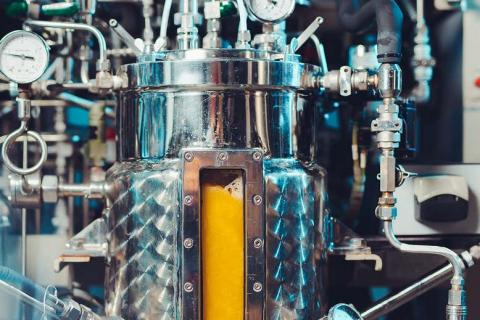Bioreactor make food from air and electricity
“This could have very beneficial impacts on the environment,” says Dorian Leger at the Max Planck Institute of Molecular Plant Physiology in Germany. “If you have 10 square kilometres of soya bean fields in the Amazon, hypothetically you could make that 1 square kilometre of solar panels and reforest the other nine.”
Ideally, he says, food production would be moved to areas that aren’t biodiversity hotspots. The idea of “food from air” is to use renewable power to capture carbon directly from the air and turn it into a simple compound, such as formate, that bacteria can feed on. Several companies are trying to commercialise food from air. For instance, Solar Foods of Finland aims to have a demonstration plant running in 2023.
Some of the processes involved are already established. A company called Calysta is already producing animal feed made from bacteria fed on methane, but the methane is derived from fossil sources. While all the technologies necessary to turn food into air using electricity do now exist, there has been debate about how it would compare to conventional farming in terms of yields and land use. So Leger and his colleagues have carried out the most detailed analysis to date, based on empirical data wherever possible.
For instance, while solar panels can turn 20 per cent of light energy into electricity, in practice solar farms tend to capture just 5 per cent of the available energy, because not all the land is covered in solar panels and so on. For conventional farming of crops including soya, sugar cane, rice and wheat, the team used average yields in 180 countries from 2017 to 2019.
The team’s conclusion is that per area of land, more than 10 times as much protein could be produced via food from air compared with growing soya. Soya is the most protein-rich staple crop and is widely used as an animal feed. In places such as the Amazon, ever more land is being deforested to make way for soya farms and cattle ranches, harming wildlife and releasing carbon dioxide. The growth of bioenergy crops is also increasing demand for land and thus driving habitat loss.
Per area of land, the process could also produce food with at least twice the caloric value of crops such as maize, wheat and rice, the study concludes. “Can we do better than what crops can do after millions of years of evolution and breeding? Our analysis indicates that it’s possible,” says Leger.
Staple crops typically convert less than 1 per cent of solar energy into harvested biomass, he says. The many reasons for this include the fact that plants harness less of the solar spectrum, can be harmed by excess light and have to balance capturing carbon dioxide with water losses. What’s more, only a small part of most crop plants is edible, and most don’t grow in winter.
As the technologies improve, the yields of food from air could improve yet further, says Leger.
Mikael Kuitunen

